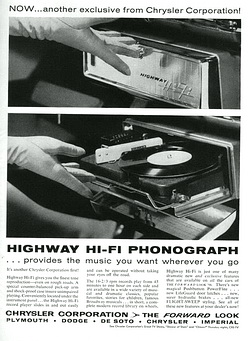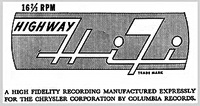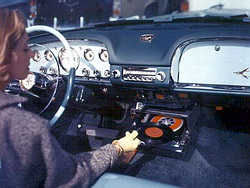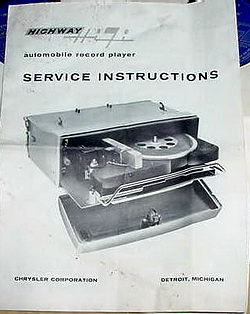|
A History of 16 RPM Records, Part One
Chryslerís Highway Hi-Fi
by Mark Quail

|
|
Chrysler Magazine ad, 1956
|
|
|
[This article arises from a CAPS presentation in November 2009 that discussed 16 2/3 rpm records and the main uses in which they were found.]
The Highway Hi-Fi was a $200.00 option available on Chrysler's Plymouth, Dodge, De Soto, Chrysler and Imperial vehicles, starting with the 1956 model year.

|
|
The Highway Hi-Fi logo
|
|
|
In his 1973 autobiography, Dr. Peter Goldmark, the CBS Laboratories engineer and famed inventor of the 33 1/3 RPM microgroove record, discusses his role
in the development of the Highway Hi-Fi. After being asked by his son why there were no sources of interesting material for play in cars, other than the
static-plagued AM radio (and remember there were not so many radio stations available in the early 1950s, either Ė so this was a problem of quantity as
well as quality), Goldmark got to thinking:
When I got back to work, I started to wonder how much information one can put on a small record for use in a car without a changer. The answer, it turned out,
is easy to figure. To give us forty-five minutes of playing time on a side, as much content as both sides of an LP, and to give us a record small enough to
fit with its mechanism inside the glove compartment, the record would have to be seven inches in diameter and would have to revolve at 16 2/3 rpm, one-half
of the LP speed. In addition it required almost three times the number of grooves per inch as did the LP.[1]
Described as the ultra-microgroove, the grooves on these records were one-third the width of a human hair and the fidelity was superb.
Enthused by the results from the lab, but being discouraged somewhat by his bosses' long-range views on the idea of a record player in a car
(it might cause the driver to tune out from CBS' radio stations), Goldmark decided to approach an engineer at Chrysler on his own. The initial testing
with the Chrysler executives went well. The system that Goldmark had developed withstood all the hard driving tests that Chrysler could throw at it.
As well, the timing for this car accessory was right, as it fit the new advertising approach highlighting glamour that Chrysler wanted for its vehicles.
No doubt Chrysler wanted to tap into America's growing prosperity as the 1950s progressed.

|
|
Highway Hi-Fi mounted in a car
|
|
|
Therefore, arrangements were made for CBS' Electronic Division to manufacture the units for Chrysler and for CBS Records to press the 7-inch vinyl records.
But even after a successful initial introduction to the public and a preliminary run of 18,000 record player units, the sales did not really take off.
The reasons for this vary, depending on the source. In Goldmark's autobiography, he agrees that there were complaints from Chrysler regarding the way the
record players worked, but he lays the blame on Chrysler and Columbia Records for not properly marketing the availability of additional records. Without such a
stimulus, car buyers did not readily choose the Highway HiFi as an option in their new vehicles. Chrysler supplied an initial set of records to those who
purchased the units, but there was no subsequent follow-up to the consumer from either Columbia Records or from Chrysler. One can assume too, that as the
records featured only Columbia recording artists, the limited selection would not have been enough to capture the public's attention. As well, the system
would have had limited appeal to the consumer, because the records could not be played on the standard home audio system of the time. "When an owner disposed
of his auto, he inevitably had to turn over his record collection with it, unless he took the Highway Hi-Fi set with him (in which case installation in his new
car became a problem [because the Highway Hi-Fi required a connection on the car radio in order to access the car's speakers] italics are author's
addition)."[2] The website RoadkillOnTheWeb notes that, "If you read between the lines on the service bulletins
related to the player, you can see that they had service problems. The cost to Chrysler, as claims were made on the warranty, began to mount. After a short time,
the dealers were to send customers to authorized radio repair shops instead of trying to fix the units themselves."[3] In his book, Jack Greenfield notes that:
In addition to all this, Highway Hi-Fi utilized an AC induction motor, incorporating a vibrator power-supply into its design to convert the auto DC power to
a suitable AC operating power. (The reader will recall that the electromechanical vibrator is a notorious noise producer, and perhaps has the highest failure
rate of all the components used in auto radios.) The owners of Highway Hi-Fi were determined to be a small, exclusive minority and, like all small, exclusive
minorities, they were destined to fade away.[4]

|
|
Highway Hi-Fi Service Manual
|
|
|
As such, Highway Hi-Fi was discontinued as an option at the beginning of the 1957 model year.[5] While reports sometimes mention the players appearing in
models as late as 1959, a dealer could have easily installed one in a later car as long as it had the top-of-line radio with proper plug receptacle on the
side.[6] On a side note, Chrysler made a short-term effort with an in-car 45 RPM player from RCA, but operating difficulties saw that cancelled after the
1961 models. Of course, coming from RCA, records from artists other than Columbia were now available. The most valuable of these discs is Elvis Presley's
entire first album with the picture sleeve stating "For Auto Use Only". This disc has been known to command several thousand dollars at auctions.
Technical Specifications:
The records were cut 550 grooves to the inch (twice that of a standard LP). As one would imagine, because of the incredibly narrow grooves, the stylus
required to play the records was tiny. At a quarter-mil, the playback stylus was one-fourth the size of the standard 1-mil monaural LP styluses in place
at the time.[7] The stylus was operated with a pressure of 2 grams. This is one of several reasons that, when Highway Hi-Fi discs are located, they are
damaged usually beyond use. Ignoring the warnings on the discs and the sleeves, and playing the discs with a standard stylus, is tantamount to playing a
33 1/3 RPM LP disc with a 78 RPM stylus.
The Discs
Chrysler, Desoto, Dodge, Imperial or Plymouth buyers choosing the Highway Hi-Fi option received the first 6 records in the series in a box set, along
with a registration card, an order form for more records and a carrying case. Only 36 discs were available when the option first came out, with an
additional 6 added in early 1956 for a total of 42 available to the general public. Songs performed by Doris Day, Mitch Miller and Tony Bennett, and
larger works like Beethoven's 5th Symphony, formed the type of repertoire available.[8]
As well, the discs themselves were thick (up to twice the vinyl of regular 7-inch records), so as to prevent warpage from being left in the car. These
Columbia discs could hold between 45 minutes and an hour's worth of recorded material on each side.
Canít Wait for an 8-Track
Music enthusiasts not satisfied with the offerings on radio would have to wait a few years in order for tape technology to be developed, as the record
player and the automobile were not a match made in heaven.
References
- Goldmark, Peter and Lee Edson, Maverick Inventor, My Turbulent Years at CBS (New York: Saturday Review Press 1973). An excerpt from this book
can also be found at: www.imperialclub.com/Repair/Accessories/HiWay/invent.htm
- Greenfield, Jack, Practical Auto Radio Service and Installation (New York: Gernsback Library Inc. 1960) pg. 152-153
- See www.roadkillontheweb.com/arp.html
- Greenfield, Jack, Ibid
- See www.roadkillontheweb.com/arp.html
- See www.roadkillontheweb.com/arp.html
- See 78rpmrecord.com/altformat.htm
-
For a list of the entire Highway Hi-Fi record catalogue (42 titles) see ookworld.com/hiwayhifilib.html
|